There is an article about pencils at the Chicago Tribune today.
There are brief interviews with a number of well known people.

exploring the art and science of pencils since 2005
There is an article about pencils at the Chicago Tribune today.
There are brief interviews with a number of well known people.
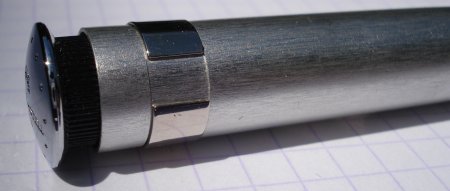
Next in our “Perfect Pencil” series, we are going to look at the Design Perfect Pencil, which features an aluminum pencil extender.
It is typically sold in a paper and plastic box with the extender and three of the refill pencils.
The product is interesting in itself, and also an intermediate step between the plastic and precious metal versions of the product.
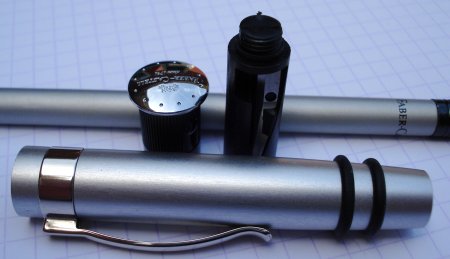
The pencils supplied are round, supplied in black or brown, and more recently silver.
The extender presents itself as a single rounded aluminum piece. It grips the pencil with a smooth tapered fit – no machinery to fiddle with. (Not that fiddling with machinery is a bad thing.) It is adorned with two black rubbery rings and a clip.
A silver coloured cap pulls out with an attached sharpener. The sharpener is the same model used in the Castell Perfect Pencil. However, the sharpener works magnificently! It is a wonder of concision, economically stuffing a first rate pencil sharpener into the extender.
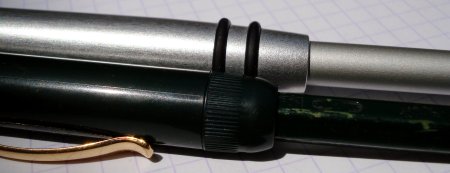
It works well, and the extender matches the silver pencil very well.
I like it, and it is easy to use, though the supplied pencils don’t seem quite up to snuff. (Great design, but not half as smooth as the 9000 in B.)
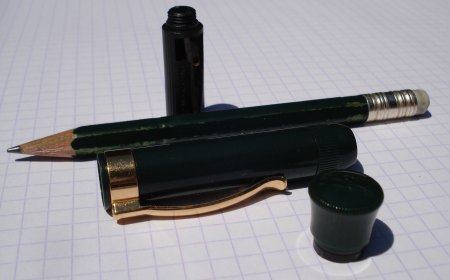
This article is the first in a series on Faber-Castell’s “Perfect Pencil” line.
The Perfect Pencil is a pencil extender with a clip. Newer versions also have a built in sharpener. The mechanisms and materials vary through the product range.
Today we’ll look at the basic model, the Castell Perfect Pencil.
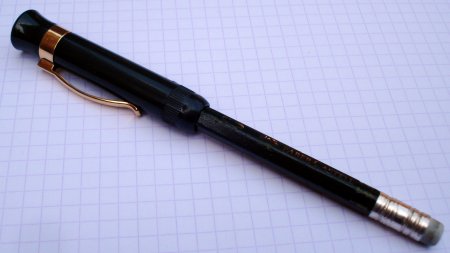
Sold loose or in a blister pack, the product is a sharpened Castell 9000 pencil with eraser, shorter than standard length. The pencil has a plastic green extender, which caps the pencil. The extender provides a metal clip.
This extender is the essence of the product. The extender can be used as a point protector while transporting the pencil, and as an extender as the pencil wears down.
The top of the extender has its own cap, which pulls out to reveal a portable sharpener. The sharpener can be unscrewed and replaced. The extender is removed by twisting a screw-on end part.
As you may see from the photos, my perfect pencil is quite worn from use. I really like it, and use it a lot. It makes a pencil very portable and usable – protecting the point, providing a clip, and supplying a super compact sharpener.
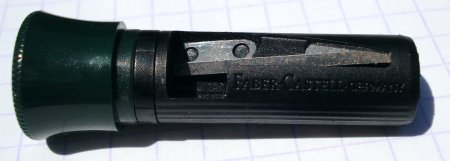
A more subtle point as well – the matching of the famous green of the Castell 9000 pencil in the extender creates a nice flow and look. You can use another pencil with the extender, but the 9000 naturally fits. A Musgrave Unigraph might also go well.
Some negatives –
The sharpener is a disappointment. It has to be held in a very specific way to get it to sharpen, and even then barely works. Yet – I have other perfect pencil sharpeners that are excellent. So I’ll call it a quality control problem. The parts are so small that they likely have to be made to very specific tolerances, and were sub-par on the particular one I bought.
A white eraser will tend to be quickly become not so white if carried around. Not a big deal to me, and as we’ll see, not an issue in the higher end products.
The little end part that is twisted to allow the extender to be removed can be unscrewed and lost.
Price. Regular blog readers will know that we don’t usually focus on product costs. But this item has a premium price in many markets including Canada, yet is mainly plastic. To put it in relative terms – this extender will cost more than a dozen Castell 9000 pencils in my local market. I have no disagreement with anyone who would rather have those dozen pencils!
I looked at one possible substitute last week, also not so cheap, and have to conclude that more competition in this area would be good. How about some investment in the ergonomics of pencil extenders. We have looked at pencil extenders before – and the truth is that these “extenders” are last resorts. Surely someone could come up with a comfortable, lightweight alternative, that ergonomically flows from the pencil. (The Staedtler 900 25 does better, and I have seen a few photos of other types of extenders, such as the one made by Itoya, but have not directly seen or used them.)
And the positives –
It remains an innovative and unique way for those of us who use and like woodcase pencils to transport, maintain, and use them. The product implementations many key pencil use principles – safety, portability, sharpening, and erasure.
It works, and is very practical – it can take considerable use, even some abuse, and continue functioning.
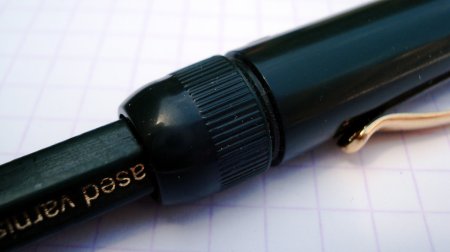
And a small update – there appears to be a newer, lower priced version on some markets, though I haven’t yet seen one.
Must a successful pencil manufacturing business be part of a multinational conglomerate? Is there any room for smaller firms in the current marketplace?
Many of us may not have heard of Viarco. They are a 94 year old pencil company from João da Madeira, Portugal, who produce a wide range of pencils – writing pencils, drawing pencils, carpenter’s pencils, and yes, even copying pencils and red and blue pencils – with a staff of twenty-eight!
Their website is a breath of fresh air compared to many pencil industry sites, revealing considerable pride in their history, as well as many details about the pencil manufacturing process. Sample fact – graphite cores are baked at 1020ºC.
I was really happy when Gunther kindly sent me a couple of Viarco’s red and blue pencils.

The pencils are the 289 Viarco Comercial (regular size, hexagonal) and 293 Viarco Olimpico (oversize, hexagonal).
The lead centering isn’t the best.
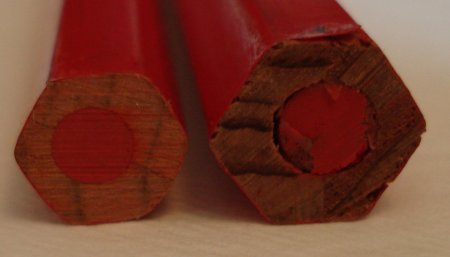
My first pleasant surprise was realized while attempting to sharpen the Comercial – it doesn’t fit in some sharpeners! It is the unreformed size of pencils that were made fifty years ago, though the edges are rounded, like modern pencils.
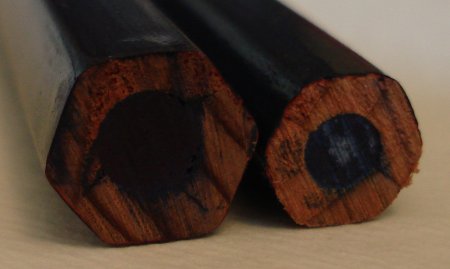
Both the Comercial and Olimpico sharpened easily. I don’t know what wood they use, but it looks like cedar to me.
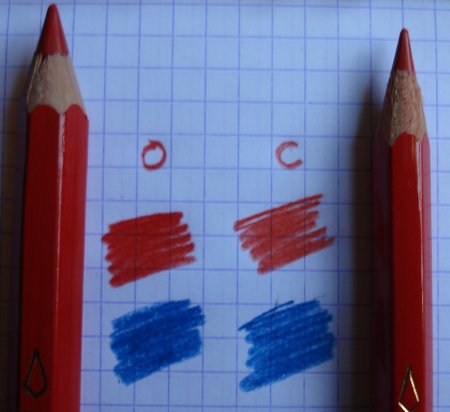
The second surprise was the rich, vibrant marks they make. The Olimpico in particular is among the best of the red and blue pencils I’ve yet seen. The Comercial’s blue is also good, but the red is more of a red-orange.
If I could buy them locally, I would get a huge stash of the Olimpico. It writes extremely well, and is very easy to use. Some of the other red and blue pencils I’ve seen, like colour pencils in general, have a tendency for the leads to easily break – but not the Viarco pencils.
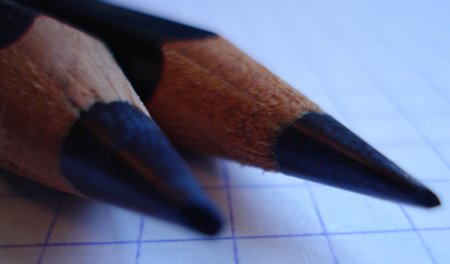
I’ve tried to email Viarco more than once, and haven’t yet heard from them. That’s okay. With twenty-eight employees, I imagine that their correspondence staff might be busy in the paint booth, or be driving a forklift.
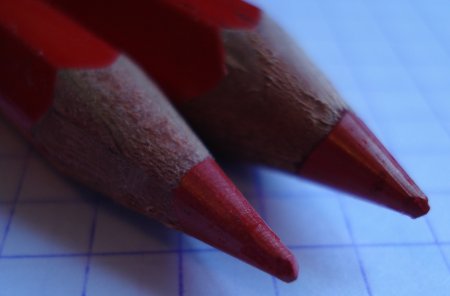
So about our original questions – let’s hope there is still room for great smaller manufacturers like Viarco, who have done a great job with these pencils.
Further on red and blue pencils:
From penciltalk.org:
Red and Blue pencils
Red and Blue pencils II
Television! (The Conté Television 649 red and blue pencil)
From stdk.de:
Rot-Blau-Stifte
This is the two hundredth post at pencil talk.
The site is hard to locate in online search engines and directories, but I’m glad that you’ve found it!
A few thoughts about the site:
Some network hardware that connects to the web server was recently replaced, and I expect that the site will experience much less downtime (So far, this has been true).
Last December, I indicated several topics that would be covered this year, and I check the list from time to time to make sure that we are still on course. Everything mentioned is still on track.
A special greeting to those who don’t actually visit the website, but read the articles through Bloglines, Google Reader, Newsgator, Planet, Newsfire, Feedshow, or other such services. Welcome!
And, if you just want to say hello, you are most welcome!
Pencil aficionados are aware that many of the pencil brands of yesteryear are now owned by Sanford, a division of the huge conglomerate Newell-Rubbermaid.
Sanford has acquired a lot of brands over the years, including hundreds of pencil names once owned by Eberhard Faber.
As a global firm, the offerings vary from market to market. Sanford Venezuela still makes the Mongol, and Berol UK (also in the family) still make the Venus and a Mirado version. And that’s just the tip of the iceberg!
Here, we’ll take a look at Sanford’s US woodcase graphite pencil offerings, extracted from their website.
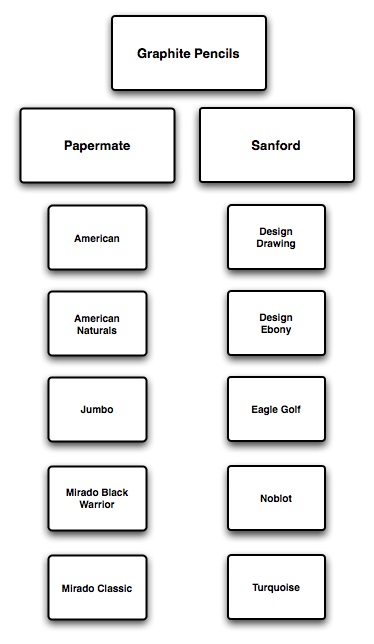
On the graphite side, there are two brand labels used – Papermate, and Sanford. Papermate offers the writing/office pencils, while Sanford handles the art/drawing pencils.
Oh, and one other pencil on the Sanford side – the Eagle Golf pencil. Ouch. One of the great names in pencil history has been reduced to hawking golf pencils.
I suspect that we won’t be seeing anything new on the pencil front from Sanford. Between competition from inexpensive Chinese made pencils and a declining market, Sanford/Newell-Rubbermaid seem to have decided to put their energy elsewhere.